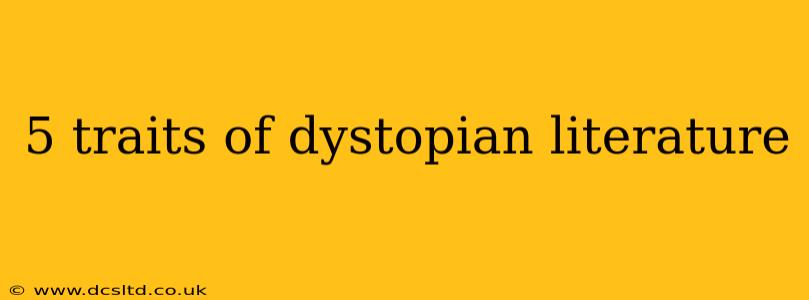5 Key Traits of Dystopian Literature That Will Leave You Thinking
Dystopian literature, a genre exploring imagined societies characterized by oppressive societal control and a lack of individual freedom, has captivated readers for decades. From the chilling realities of 1984 to the unsettling conformity of The Handmaid's Tale, these narratives offer potent social commentary and warnings about potential future pitfalls. But what exactly makes a piece of literature truly dystopian? Let's delve into five key traits that define this compelling genre.
1. Protagonist's Journey of Self-Discovery and Rebellion: At the heart of most dystopian narratives lies a protagonist who questions the established order. This character, often initially unaware of the oppressive nature of their society, embarks on a journey of self-discovery as they uncover the truth and begin to resist the system. Their rebellion, however small at first, acts as a catalyst for change and highlights the inherent human desire for freedom and autonomy. This is exemplified in Katniss Everdeen's rebellion in The Hunger Games, or Winston Smith's struggle against Big Brother in 1984. Their internal conflicts and external struggles form the core of the narrative arc, capturing the reader's empathy and engagement.
2. Controlling Government or Authority: A defining feature of dystopian fiction is the presence of a powerful, all-encompassing government or authority that exerts absolute control over its citizens. This control can manifest in various forms—from totalitarian regimes wielding physical force to subtle forms of social manipulation and technological surveillance. The mechanisms of control are often meticulously crafted, creating a sense of inescapable oppression and highlighting the potential dangers of unchecked power. Think of the Party's omnipresent surveillance in Orwell's 1984, or the Gilead regime's strict religious control in Atwood's The Handmaid's Tale.
3. Loss of Individuality and Conformity: Dystopian societies often suppress individuality and enforce strict conformity. Citizens are expected to adhere to rigid societal norms and suppress their unique thoughts and feelings. This loss of individuality is often enforced through propaganda, surveillance, and the suppression of dissenting voices. The chilling uniformity depicted in these narratives serves as a powerful commentary on the dangers of suppressing creativity and critical thinking, and the importance of individual expression. The conformity seen in Fahrenheit 451 and the rigid social structures in Brave New World exemplify this trait.
4. Dehumanization and Technological Control: Many dystopian societies utilize technology to monitor and control their citizens, often leading to dehumanization. This technology can range from advanced surveillance systems to sophisticated methods of mind control, effectively stripping individuals of their agency and autonomy. The use of technology as a tool of oppression is a recurring theme, underscoring the potential downsides of technological advancement when unchecked by ethical considerations. This is evident in the advanced surveillance systems of 1984 or the genetic engineering of Brave New World.
5. Depiction of a Dystopian Setting: The setting itself plays a crucial role in establishing the dystopian atmosphere. These settings are often bleak, desolate, and reflect the oppressive nature of the society they inhabit. The environment can be polluted, impoverished, or meticulously controlled to reinforce the regime's power. This physical manifestation of the dystopian world adds another layer to the overall feeling of oppression and hopelessness, making the reader feel the weight of the oppressive regime. Examples include the war-torn landscapes and polluted cities often depicted in post-apocalyptic dystopias.
H2: Frequently Asked Questions about Dystopian Literature
H3: What is the difference between dystopia and utopia?
A utopia represents an ideal society, characterized by perfect conditions and happiness. A dystopia, conversely, is the opposite – a seemingly perfect society that hides a dark, oppressive reality beneath its surface. While utopian ideals can serve as the starting point for a dystopia's creation, the two are diametrically opposed in their overall portrayal of society.
H3: Is dystopian literature always about the future?
While many dystopian novels depict a futuristic setting, it's not a requirement. Some dystopian narratives explore present-day societal issues or even historical periods through a lens of oppression and control. The temporal setting is less important than the core themes of societal control, loss of freedom, and the struggle for individual expression.
H3: What is the purpose of dystopian literature?
Dystopian literature serves as a powerful tool for social commentary. By presenting exaggerated or nightmarish versions of societal trends, these narratives raise awareness about potential dangers and encourage critical thinking about the present and future. They act as cautionary tales, prompting readers to question established power structures and advocate for social justice.
By understanding these five key traits, readers can better appreciate the nuances and complexities of dystopian literature and its enduring relevance in exploring the human condition and the potential dangers of unchecked power. The genre’s continued popularity testifies to its ability to engage, provoke, and offer valuable social commentary.
